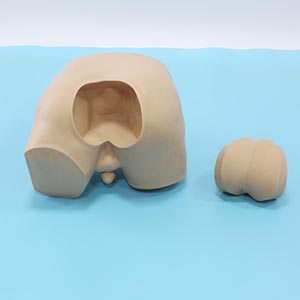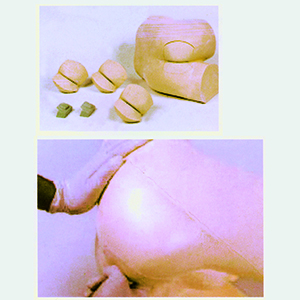Welcome to visitShanghai Chinon medical Model & Equipment Manufacturing Co., LTD
Digital rectal examination (DRE) is a long-established and highly effective clinical examination method, which is widely used in the preliminary diagnosis of anorectal diseases. Despite the rapid development of imaging methods such as endoscopy, CT scan and MRI with the advancement of medical technology, digital rectal examination still plays a crucial role in the diagnosis of anorectal diseases. It can not only provide doctors with intuitive signs, but also provide patients with initial diagnostic direction in a short time, and is an efficient screening tool for many common anorectal diseases.
The role of medical technology and the advantages of digital rectal examination

Digital rectal examination model
Digital rectal examination is a simple, non-invasive and low-cost examination method to quickly assess the anorectal health status of patients. Through the doctor's touch, a digital rectal examination can detect many early lesions that are difficult to detect through other tests. In particular, digital rectal examination shows its irreplaceable role in the following aspects:
1. Early detection of lumps and tumors : Digital rectal examination can detect early signs of malignant or benign tumors by touching lumps in the rectum and anal area, especially rectal cancer. Studies show that in the early stages of rectal cancer, digital examination can reach about 60-80% of rectal tumors.
2. Check rectal function : Digital rectal examination can also effectively assess the functional status of the rectum and anus, especially the detection of the tension and sensory capacity of the anal sphincter. This is especially important when diagnosing problems such as chronic constipation and rectal prolapse.
3. Identification of hemorrhoids and anal fissures : For common hemorrhoids and anal fissures, digital rectal examination can help doctors quickly locate the problem area, distinguish internal hemorrhoids, external hemorrhoids and other anorectal lesions, and then make a reasonable treatment plan.

The views of industry experts
Industry experts generally agree that despite advances in medical imaging technology, digital rectal examination is still the "first step" in assessing anorectal health. Many proctologists point out that digital rectal examination is not only the basis for diagnosing anorectal diseases, but can also help identify some early lesions through palpation, especially if high-end imaging equipment is not immediately available. Experts point out that digital rectal examination is the first way to understand the nature of the rectal mass, anal sphincter function, and anal patency, often providing critical information for further diagnostic decisions.
Data support
The study data further proved the central role of digital rectal examination in the diagnosis of anorectal diseases. According to a comparative study of different diagnostic tools, digital rectal examination showed a 60-80% sensitivity in the detection of early rectal cancer, especially when the mass was located in the lower rectum or near the anus. In addition, another study has shown that for some common anorectal diseases, such as anal fissures and hemorrhoids, the accuracy of digital rectal examination can reach more than 90%.
Digital rectal examination is not only widely used in clinical diagnosis, but also plays an important role in patient management. Most anorectal specialists say that with a digital rectal exam, doctors can spot potential red flags in time to direct patients to further tests, such as anoscopy, colonoscopy or imaging tests, as needed. In this process, digital rectal examination plays the role of "guide".
Clinical application and practice

Although imaging techniques such as endoscopy, CT and MRI have gradually become routine diagnostic means for anorectal diseases, digital rectal examination still occupies an irreplaceable position in many clinical practices due to its rapidness, low cost and high efficiency. For example, in emergency or primary care Settings, digital rectal examination is often the preferred method for initial screening of anorectal patients. Its simplicity and rapidity not only reduce the waiting time for patients, but also provide timely decision support for subsequent treatment.
In daily clinical work, digital rectal examination, as a low-cost and efficient means of preliminary screening, is especially suitable for some areas or hospitals with relatively poor infrastructure. For example, in primary hospitals in many developing countries, digital rectal examination is undoubtedly a fundamental and critical skill for diagnosing anorectal diseases due to the poor availability of expensive endoscopy equipment and other imaging tools.
Conclusion
Despite the continuous innovation of modern medical technology, digital rectal examination still plays an important role in the diagnosis of anorectal diseases. By virtue of its simplicity, speed, and low cost, digital rectal examination can effectively help doctors detect early lesions, make timely diagnostic decisions, and guide patients to further examinations. This examination method not only provides intuitive pathological information for anorectal doctors, but also provides a rapid diagnostic path for patients, especially in the primary medical environment has irreplaceable value. Therefore, digital rectal examination is still one of the "gold standards" in the diagnosis of anorectal diseases.
|
NEXTпјљDoes the male torso model provide enough detail to support clinical training?
LASTпјљIs the demand for leg venipuncture models growing? |
Return list |